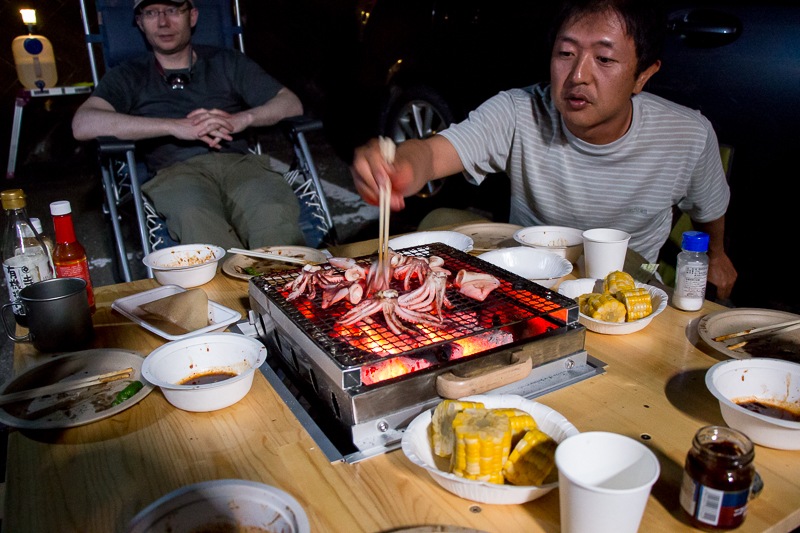I was looking through some of the photos that John and me took on previous visits to Japan recently – and it made me hungry!…

Literally “hungry”, since there are so many delicious dishes that we’ve encountered directly because of tenkara (whether that is on events in our home country, Italy or Japan) – and like any other tourist; we find that a photograph to remind you of that experience is compulsory. Of course, those meals are not only about the food (just as tenkara is not only about the fishing). Instead, in both cases, it is really about the community of friends and shared stories that result.
I posted a few pictures on the Tenkara in Focus Facebook group to try to convey some of those wonderful memories and I hope that our enjoyment of those experiences comes across. I’m sharing some more here (like the ones above and below of Saigo-san “Ajari” at camp making some bbq squid on Makino-san’s home-built folding bbq pit table).

Don’t worry though – no cooks or diners were harmed in the making of these photos (well, not permanently anyway).

Of course, in Japan, the food on its own is often an event. Whether it is the refined, complex and extensive home cooking of the traditional “ryokan” inns – or especially a big city sophisticated restaurant…The technical ability of chefs across the country is incredibly impressive. And even the simplest ideas are just perfectly presented and executed…

But one thing I did notice from the Facebook posting was the interest in “Shioyaki” (salted, crispy BBQ fish). So I thought I’d share a little insider info on the ones that Go-chan, Kura-san, Ajari and Otani-san made for some camp-fire cooking by the wood and charcoal fires.
First of all, I should say that these were iwana and amago bought from fish-farm origin (rather than wild fish caught during the day). The tenkara community seems to be leading the way in terms of promoting more C&R fishing in Japanese rivers (which is still extremely rare).
The dish is so simple, but as Go said on Facebook, the small differences in preparation make a big difference to the end result…It starts with fresh fish of course; but the process of hanging for several hours to allow some of the moisture to evaporate from the flesh shrinks the fish a little.

This seemingly simple part of the process is critical – as well as firming the flesh it also intensifies the flavour…But how long is long enough? And how long is too long and the delicate flavour begins to spoil?? It is a black art!
Then a dusting of salt is added to the fish and they are threaded onto thick bamboo skewers ready to be roasted on a very gentle heat (usually not directly on the fierce heat of the grill)…

The end result usually ends up looking like the picture below within a few seconds of it being served though…They are just too delicious to take your time with; crispy, sweet, super savoury and firm juicy flesh. Yum.

And I haven’t even got onto the turban shells yet (or “sazae” as I learned just the other day)…John considers his next course of “sazae surprise” below:

OK, that is probably enough for now (though there is tons more I want to tell you about when I get chance).
Lobsters, Epic Ramen, Shabu-Shabu …and that is even before thinking about Italy!!
Paul
